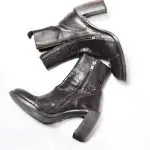I've always been drawn to satin's sleek look for my projects, but let's be honest, it's not the easiest fabric to work with. Its slippery nature means you're in for a bit of a wrestling match when you're cutting or sewing, and don't get me started on the snagging. Every time I think I've gotten through without a hitch, I find a new snag or pull. And if you're as clumsy as I am, keeping it stain-free is a whole other game. But the real kicker? Wait until you hear about its environmental impact and the cost.
Table of Contents
Key Takeaways
- Satin is slippery and challenging to handle or sew, requiring patience and skill.
- Prone to snagging and surface abrasions, satin demands careful handling.
- Requires special care, including professional dry cleaning and low heat ironing, to maintain its appearance.
- Its one-sided shine limits versatility for reversible garments and necessitates careful cutting and sewing.
- Sensitive to stains and water, making spills difficult to remove and requiring specific care techniques.
Slipperiness and Handling
While satin's sleek look is appealing, its slipperiness makes it a real pain to handle and sew. Anyone who's tried knows that its slippery texture isn't just challenging; it's like trying to sew water. You need a good dose of experience to master working with it, or you'll find yourself fighting the fabric more than shaping it. This isn't just about wrestling the fabric under your sewing machine, either. Delicate satins show every needle hole, meaning every mistake is there for the world to see. You can't just rip out a seam and start over without leaving evidence of your battle.
And don't even think about throwing it in the machine washer after all that hard work. Satin demands the royal treatment of dry cleaning, because machine washing? That's a disaster waiting to happen. It's not just about keeping it looking its best; it's about keeping it intact. So, while I love the look of satin, working with it's a test of patience and skill. It's a commitment, not just a fabric choice.
Prone to Snagging
Beyond the challenges of handling and sewing satin, it's also super easy for this fabric to snag. The thing is, satin's delicate weave structure is sort of a double-edged sword. It gives satin that gorgeous, shiny surface we all love, but it also makes it a magnet for snags. Even a tiny, rough edge on a fingernail or a piece of jewelry can catch on this fabric, leading to pulls. And once you've got a pull, it's practically an open invitation for surface abrasions, which can totally ruin the look.
What's more, the silky, slippery texture of satin doesn't help. You'd think it'd make everything glide off, but it's actually part of why snagging is such a nuisance. The fabric slides around so much that it's more likely to catch on anything it comes in contact with. So, if you're sporting a satin outfit or using satin in your sewing projects, you've got to be extra mindful. Careful handling and maintenance aren't just recommended; they're essential to keeping those snags at bay. It's all about preserving that smooth, elegant appearance that makes satin so special.
Special Care Requirements
Talking about satin's care, it's not as simple as tossing it in the wash. It wrinkles easily, demands high maintenance cleaning, and can't stand up to heat.
Prone to Wrinkling
Satin's tendency to wrinkle easily means you'll need to give it some extra TLC to keep it looking sharp. Due to its delicate nature, satin can succumb to creases and wrinkles if you're not careful. Here's what I've learned to handle satin's special care needs effectively:
- Always iron satin on low heat and inside out to avoid damaging the fabric.
- Consider professional dry cleaning for your satin garments to prevent excessive wrinkling.
- Proper storage is key; hang satin items or lay them flat to minimize creases.
- Handle satin gently to avoid unnecessary wrinkling during wear and storage.
Sticking to these tips has definitely made a difference in maintaining the polished look of my satin pieces!
High Maintenance Cleaning
Caring for satin isn't as simple as tossing it into the wash; it often requires a trip to the dry cleaners. Especially if it's made from delicate silk, avoiding damage is key. Satin demands special care to dodge shrinkage, color fading, or those dreaded water spots.
After cleaning, I've learned it should be air-dried. This step maintains its luster and sidesteps damage from heat, something I'm always cautious about. Harsh chemicals or bleach are a big no-no. They can ruin the integrity of the fabric in a heartbeat.
I always make sure to check the garment label for care instructions. It's crucial for keeping my satin looking its best, ensuring its longevity and quality.
Sensitive to Heat
One thing I've learned is that satin hates heat, needing that extra bit of care when it comes to ironing and washing.
Here are a few tips to keep in mind:
- Always use a low heat setting on your iron to prevent damage.
- Use a pressing cloth when ironing to shield the satin from direct heat.
- Avoid high temperatures during washing and drying to prevent shrinkage and wrinkles.
- Never apply direct heat from irons or dryers, as it can make satin lose its smooth texture and sheen.
One-Sided Shine
While the front side of satin boasts a beautiful shine, the back remains noticeably duller, limiting its versatility in certain designs. This one-sided shine can be a real bummer for folks like me who like to push the envelope with design options and creativity.
You see, when you've got fabric that only looks good from one angle, it kinda puts a damper on making reversible garments or anything that needs a uniform shine on every surface.
It's not just about aesthetics, either. This limitation means you've got to be extra careful about the direction of the fabric when you're cutting and sewing. If you're not paying attention, you could end up with parts of your project looking mismatched or off because the shiny side isn't facing the right way. And let me tell you, that's not a mistake you want to make, especially after you've put hours into a project.
Durability Concerns
Another major downside to satin is its lack of durability; it's super easy to snag, pull, or scratch because of how it's woven. This delicate nature stems from its weave structure, making it a risky choice for those of us who aren't exactly gentle with our belongings. Plus, if you're into sewing, satin can be a real pain. Its slippery texture doesn't just challenge your patience; it demands precision because every mistake shows.
Here's a quick rundown of why satin might've you treading carefully:
- Prone to damage: The weave structure makes it susceptible to snags and pulls, leaving your satin items looking worn out faster than you'd hope.
- Shows sewing errors: Got a bit off track with your stitching? Satin will showcase that oops moment more than any other fabric.
- Not machine washable: Most delicate satin pieces require dry cleaning, adding to their upkeep cost.
- Slippery to work with: Its texture can turn sewing projects into a slippery slope of frustration and mishaps.
Stain and Water Sensitivity
Moving on from durability, let's talk about satin's stain and water sensitivity.
This fabric demands a lot of care because it can quickly get ruined by spills or even just a bit of water.
It's a real bummer because it means you've got to be super careful to keep that luxurious look intact.
High Maintenance Required
One major downside to satin is its high maintenance, since it's easily stained and water can ruin its appearance. Its delicate nature means I've got to be extra careful around anything that might spill or splash. Honestly, keeping satin looking luxurious is a task that requires some know-how and patience.
- Sensitive to stains: Spills become a big deal, as they're tough to get out.
- Water marks: Even a little water can leave a lasting impression.
- Difficult to clean: You can't just throw it in the wash with everything else.
- High maintenance: It needs special care, from the right cleaning techniques to proper storage.
Mastering the care of satin means staying on top of these challenges to keep it looking its best.
Quick Damage Risk
Satin's quick to show damage because it really can't handle stains and water well at all. Its delicate nature means you're always on guard. If I'm not careful, even a little spill can turn into a big problem. Stains and water marks are just super challenging to remove. It's a bit of a headache, honestly. Maintenance feels like a full-time job.
| Aspect | Impact | Solution |
|---|---|---|
| Stains | Permanent Damage | Careful Use |
| Water Damage | Marks | Immediate Drying |
| Delicate Nature | Easily Damaged | Gentle Handling |
| Maintenance | Time-consuming | Professional Care |
| Removal | Difficult | Special Products |
Keeping satin looking its best is tough. You've gotta be ready to jump into action at the slightest sign of trouble.
Limited Breathability
Despite its sleek appearance, satin's tight weave significantly limits its breathability. I've found this to be a bit of a downer, especially in warmer climates or during those hot summer nights. You see, that smooth surface and tight weave that make satin look so luxurious? They're also why it's not the best at letting air flow through. This can lead to a few uncomfortable situations.
- Tight weave: It's what gives satin that glossy look but also traps in heat.
- Smooth surface: Feels great against the skin but doesn't do much for air circulation.
- Poor breathability: Means you might end up feeling clammy and uncomfortable in less ventilated settings.
- Heat retention and moisture build-up: The worst duo, making you feel hotter and potentially ruining a good night's sleep.
Considering these points, I've realized that while satin might be perfect for that fancy look or feel, it's not always the ideal choice for every situation. If you're aiming for comfort in a hot environment, you might want to look into more breathable fabrics. Trust me, your skin will thank you for the extra ventilation.
Cost Considerations
Often, the luxurious look and feel of satin come with a steeper price tag than other fabrics. It's something I've noticed when comparing materials for both projects and my wardrobe. The cost of satin isn't just about paying upfront for the fabric; it's also about what comes after.
Silk satin, for instance, is on the higher end of the spectrum. It's gorgeous and feels amazing, but it'll make your wallet feel significantly lighter.
When you're thinking about using satin, you've got to consider not just the initial cost but also the maintenance. Dry cleaning isn't cheap, and for many satin items, it's the only way to keep them looking their best. This means the overall expenses can add up quickly, something I've had to learn the hard way.
Budgeting for satin requires a bit of foresight. The luxurious appeal is tempting, but it's essential to weigh the cost against your budget. Whether it's for a special occasion dress or adding a touch of elegance to your home decor, knowing these costs upfront can help manage expectations and avoid any surprises. It's all about finding that balance between luxury and practicality.
Environmental Impact
While I love the look of satin, I can't ignore its environmental toll, especially when synthetic fibers are involved. The production of satin, particularly the kind made with synthetic fibers like polyester, contributes significantly to environmental pollution. It's tough to reconcile my love for satin's smooth feel with the understanding that it often comes from non-renewable resources, such as petroleum. Not to mention, the process of dyeing satin can release harmful chemicals into the environment if not carefully managed.
To help us enjoy the luxury of satin without the guilt, here are a few points to consider:
- Synthetic fibers contribute to environmental pollution during manufacturing.
- These fibers are derived from non-renewable resources, raising sustainability concerns.
- The dyeing process can involve harmful chemicals, posing environmental risks.
- Opting for satin made from recycled materials, like RPET fabric, or choosing eco-friendly options can significantly reduce our environmental footprint.
Frequently Asked Questions
Does Satin Get Ruined Easily?
Yes, I've found that satin does get ruined easily. It snags, can't always be machine washed, and demands special care. It's beautiful but high-maintenance, making it less durable than other fabrics in my experience.
What Are the Advantages and Disadvantages of Satin Weave?
I'm exploring the pros and cons of satin weave. It's got a great sheen and feels luxurious, but it's tough to sew and needs careful handling. I'm diving deep to understand its unique characteristics.
Is Satin Good or Not?
I think satin's great for its luxurious look and soft feel, but it's not without issues. It can be slippery, snag easily, and wrinkles are a hassle. So, it's good but needs careful handling.
Does Satin Look Cheap?
I've noticed that satin can look cheap if it's not high-quality. The low-grade kind often has a plasticky sheen that just screams artificial. It's all about choosing the right satin to avoid that cheap appearance.
- 10 Types of Crepe Fabric You Need to Know (With Pictures) - June 23, 2025
- The Difference Between “Crepe” and “Crape” Fabric Explained - June 23, 2025
- Crepe Fabric Glossary: 20 Terms Every Sewist and Designer Should Know - June 23, 2025







